-
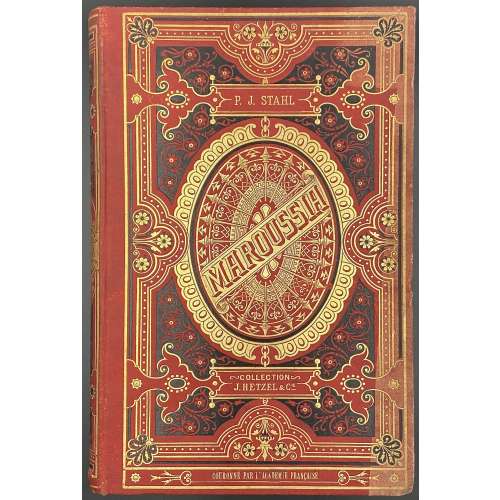 Title: MAROUSSIA | PAR | P.-J. STAHL | D'APRÈS UNE LÉGENDE DE MARKOWOVZOK | DESSINS PAR TH. SCHULER | GRAVURES PAR PANNEMAKER | {vignette} | BIBLIOTHÈQUE | D'ÉDUCATION ET DE RÉCRÉATION | J. HETZEL ET Cie, 18, RUE JACOB | PARIS | Tous droits de reproduction et de traduction réservés || Pagination: [2] – t.p. / blank, [1, 2] – dedication / blank, [3] 4-272, [1] 2-11 [12] – publisher’s advert.; Frontispiece and 22 leaves of wood-engraved plates by F. Pannemaker after Th. Schuler, extraneous to collation, woodcut head- and tailpieces, vignettes in the text by Charles Baude. Collation: 4to; 1-344, + 6 leaves of publisher's advertisement. Binding: “Cartonnage Hetzel” – red cloth stamped in gilt and black with the elements of design to spine, front and back, publisher's device to back, AEG. Author and publisher: Pierre-Jules Hetzel [P.-J. Stahl] (French, 1814 – 1886). Artist: Jules Théophile Schuler (French, 1821 – 1878). Engravers: Adolphe François Pannemaker (Belgian-French, 1822 – 1900) and Charles Baude (French, 1853 – 1935). Author of the legend: Markowovzok [Marko Vovchok; Марко́ Вовчо́к, real name Mariya Vilinskаya; Мария Александровна Вилинская] (Ukrainian, 1833 – 1907). Series: Collection Hetzel (stamped on the front board). Typographie A. Lahure (Paris), Alexis Lahure (French, 1849 – 1929). MAROUSSIA – The French version of the Ukrainian name Маруся.
Title: MAROUSSIA | PAR | P.-J. STAHL | D'APRÈS UNE LÉGENDE DE MARKOWOVZOK | DESSINS PAR TH. SCHULER | GRAVURES PAR PANNEMAKER | {vignette} | BIBLIOTHÈQUE | D'ÉDUCATION ET DE RÉCRÉATION | J. HETZEL ET Cie, 18, RUE JACOB | PARIS | Tous droits de reproduction et de traduction réservés || Pagination: [2] – t.p. / blank, [1, 2] – dedication / blank, [3] 4-272, [1] 2-11 [12] – publisher’s advert.; Frontispiece and 22 leaves of wood-engraved plates by F. Pannemaker after Th. Schuler, extraneous to collation, woodcut head- and tailpieces, vignettes in the text by Charles Baude. Collation: 4to; 1-344, + 6 leaves of publisher's advertisement. Binding: “Cartonnage Hetzel” – red cloth stamped in gilt and black with the elements of design to spine, front and back, publisher's device to back, AEG. Author and publisher: Pierre-Jules Hetzel [P.-J. Stahl] (French, 1814 – 1886). Artist: Jules Théophile Schuler (French, 1821 – 1878). Engravers: Adolphe François Pannemaker (Belgian-French, 1822 – 1900) and Charles Baude (French, 1853 – 1935). Author of the legend: Markowovzok [Marko Vovchok; Марко́ Вовчо́к, real name Mariya Vilinskаya; Мария Александровна Вилинская] (Ukrainian, 1833 – 1907). Series: Collection Hetzel (stamped on the front board). Typographie A. Lahure (Paris), Alexis Lahure (French, 1849 – 1929). MAROUSSIA – The French version of the Ukrainian name Маруся. -
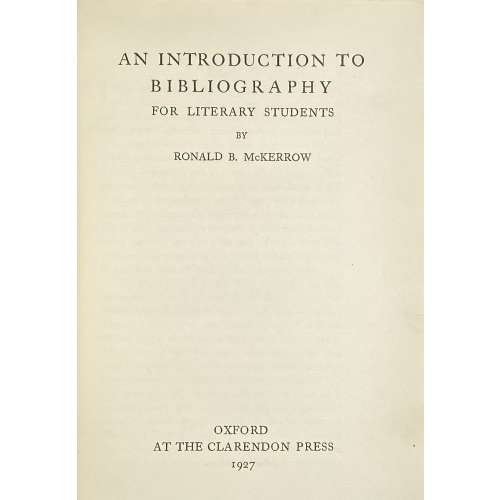 Title: AN INTRODUCTION TO | BIBLIOGRAPHY | FOR LITERARY STUDENTS | BY | RONALD B. McKERROW | OXFORD | AT THE CLARENDON PRESS | 1927 Pagination: [i-iv] v-xv [xvi blank], 1-358 [2]. Collation: [a]4 b4 B-Z4 Aa-Zz4. Exterior: 23 x 15 cm, publisher’s black cloth, gilt lettering and publisher’s device to spine. Bookseller's sticker to ffl: CHAS. E. LAURIAT CO., | IMPORTERS & BOOKSELLERS | 385 Wash’n St. Boston || – this is of Lauriat, Charles Emelius Jr. (American, 1874 – 1937).
Title: AN INTRODUCTION TO | BIBLIOGRAPHY | FOR LITERARY STUDENTS | BY | RONALD B. McKERROW | OXFORD | AT THE CLARENDON PRESS | 1927 Pagination: [i-iv] v-xv [xvi blank], 1-358 [2]. Collation: [a]4 b4 B-Z4 Aa-Zz4. Exterior: 23 x 15 cm, publisher’s black cloth, gilt lettering and publisher’s device to spine. Bookseller's sticker to ffl: CHAS. E. LAURIAT CO., | IMPORTERS & BOOKSELLERS | 385 Wash’n St. Boston || – this is of Lauriat, Charles Emelius Jr. (American, 1874 – 1937). -
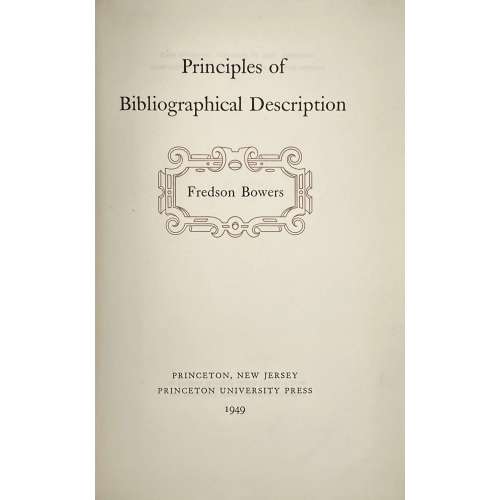 Detailed Bibliographical Description: ( Title: Principles of | Bibliographical Description | Fredson Bowers (in a frame) | PRINCETON, NEW JERSEY | PRINCETON UNIVERSITY PRESS | 1949. Pagination: [i-vii] viii-xvii [xviii] [1-3] 4-505 [506], 2 leaves of plates. Exterior: 24 x 16.5 cm, purple-grey cloth, brown label with gilt lettering to spine, DJ. Fredson Thayer Bowers (American, 1905 – 1991).
Detailed Bibliographical Description: ( Title: Principles of | Bibliographical Description | Fredson Bowers (in a frame) | PRINCETON, NEW JERSEY | PRINCETON UNIVERSITY PRESS | 1949. Pagination: [i-vii] viii-xvii [xviii] [1-3] 4-505 [506], 2 leaves of plates. Exterior: 24 x 16.5 cm, purple-grey cloth, brown label with gilt lettering to spine, DJ. Fredson Thayer Bowers (American, 1905 – 1991). -
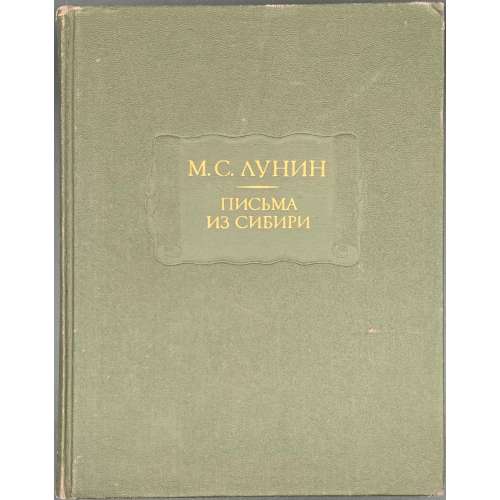 Title (black and red): М. С. ЛУНИН | — | ПИСЬМА ИЗ СИБИРИ | — | Издание подготовили | И. А. Желвакова и Н. Я Эйдельман | МОСКВА | «НАУКА» | 1987 || Pagination: [1, 2] Serial h.t. / blank, [3, 4] t.p. / imprint, [5] 6-492 [4], 1 portrait and 8 leaves of plates. Collation: 16mo; [1]16 216 38 (plates), 4-1716. Binding: serial green buckram blind-stamped with a scroll adorned with gold lettering to board and spine.
Title (black and red): М. С. ЛУНИН | — | ПИСЬМА ИЗ СИБИРИ | — | Издание подготовили | И. А. Желвакова и Н. Я Эйдельман | МОСКВА | «НАУКА» | 1987 || Pagination: [1, 2] Serial h.t. / blank, [3, 4] t.p. / imprint, [5] 6-492 [4], 1 portrait and 8 leaves of plates. Collation: 16mo; [1]16 216 38 (plates), 4-1716. Binding: serial green buckram blind-stamped with a scroll adorned with gold lettering to board and spine. -
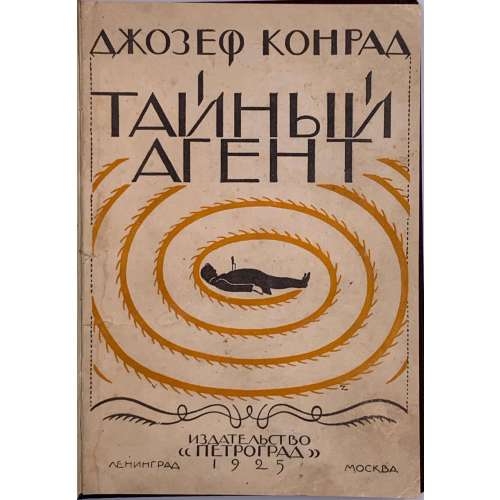 20 x 14.5 cm, owner’s burgundy buckram, upper original pictorial wrapper preserved, in black and yellow. Title: ДЖОЗЕФ КОНРАД | ТАЙНЫЙ АГЕНТ | (The secret agent) | Перевод с английского | М. МАТВЕЕВОЙ | под редакцией | В. А. АЗОВА | {device} | Издательство “ПЕТРОГРАД” | ЛЕНИНГРАД — МОСКВА | 1925. Pagination: ffl, [2] orig. wrapper/blank, [1, 2] t.p./imprint, 3-245 [3 advert.] Collation: 8vo; [1]8 2-158 164. Print run: 5.000 copies. Редактор перевода: В. А. Азов Contributors: Joseph Conrad (Polish-British, 1857 – 1924) – author. Владимир Александрович Ашкинази [Азов] (Russian-French, 1873 – 1941) – translator/editor. Марианна Николаевна Матвеева (Russian, 20th century) – translator. Original title: [LIB-2762.2021] Joseph Conrad. The secret agent: a simple tale. — London: Methuen & Co., [1907]; [LIB-3213.2023] Joseph Conrad. The secret agent: A drama in three acts. — London, T. Werner Laurie., 1923.
20 x 14.5 cm, owner’s burgundy buckram, upper original pictorial wrapper preserved, in black and yellow. Title: ДЖОЗЕФ КОНРАД | ТАЙНЫЙ АГЕНТ | (The secret agent) | Перевод с английского | М. МАТВЕЕВОЙ | под редакцией | В. А. АЗОВА | {device} | Издательство “ПЕТРОГРАД” | ЛЕНИНГРАД — МОСКВА | 1925. Pagination: ffl, [2] orig. wrapper/blank, [1, 2] t.p./imprint, 3-245 [3 advert.] Collation: 8vo; [1]8 2-158 164. Print run: 5.000 copies. Редактор перевода: В. А. Азов Contributors: Joseph Conrad (Polish-British, 1857 – 1924) – author. Владимир Александрович Ашкинази [Азов] (Russian-French, 1873 – 1941) – translator/editor. Марианна Николаевна Матвеева (Russian, 20th century) – translator. Original title: [LIB-2762.2021] Joseph Conrad. The secret agent: a simple tale. — London: Methuen & Co., [1907]; [LIB-3213.2023] Joseph Conrad. The secret agent: A drama in three acts. — London, T. Werner Laurie., 1923. -
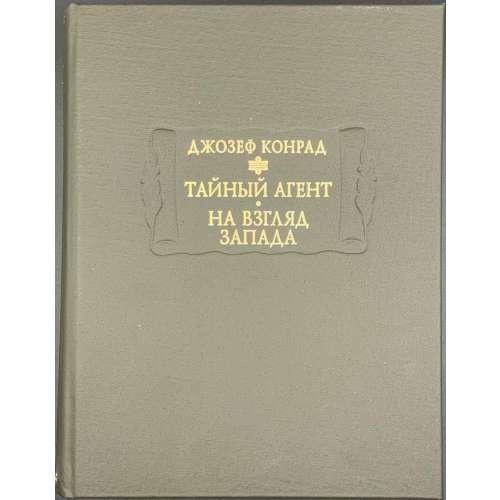 Title: ДЖОЗЕФ КОНРАД |{device} | ТАЙНЫЙ АГЕНТ | • | НА ВЗГЛЯД ЗАПАДА | • | Издание подготовил | В.М. ТОЛМАЧЕВ | Научно-издательский центр | «Ладомир» | «Наука» | Москва || Frontispiece: JOSEPH CONRAD |{device} | THE SECRET AGENT | • | UNDER WESTERN EYES || Pagination: [1-9] 10-595 [3] [2 advert.]. Binding: serial green cloth blind-stamped with a scroll adorned with gold lettering to board and spine, 22.5 x 17 cm. Original titles: [LIB-2762.2021] Joseph Conrad. The secret agent: a simple tale. — London: Methuen & Co., [1907]; [LIB-3213.2023] Joseph Conrad. The secret agent: A drama in three acts. — London, T. Werner Laurie, 1923.
Title: ДЖОЗЕФ КОНРАД |{device} | ТАЙНЫЙ АГЕНТ | • | НА ВЗГЛЯД ЗАПАДА | • | Издание подготовил | В.М. ТОЛМАЧЕВ | Научно-издательский центр | «Ладомир» | «Наука» | Москва || Frontispiece: JOSEPH CONRAD |{device} | THE SECRET AGENT | • | UNDER WESTERN EYES || Pagination: [1-9] 10-595 [3] [2 advert.]. Binding: serial green cloth blind-stamped with a scroll adorned with gold lettering to board and spine, 22.5 x 17 cm. Original titles: [LIB-2762.2021] Joseph Conrad. The secret agent: a simple tale. — London: Methuen & Co., [1907]; [LIB-3213.2023] Joseph Conrad. The secret agent: A drama in three acts. — London, T. Werner Laurie, 1923. -
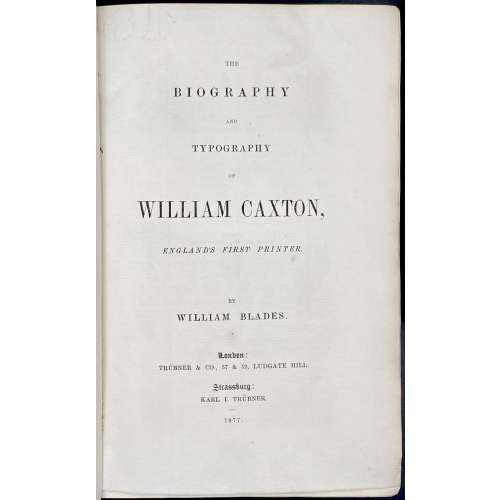 Title: THE | BIOGRAPHY AND | TYPOGRAPHY | OF | WILLIAM CAXTON, | ENGLAND'S FIRST PRINTER. | BY | WILLIAM BLADES. | LONDON : | TRÜBNER & CO, 57 & 59 LUDGATE HILL. | STRASSBURG : | KARL I. TRÜBNER. | 1877. || Pagination: ffl, [2] blank, [i, ii] - t.p., imprint, [iii], iv, v - preface, [vi] - cul-de-lampe, [vii], viii - contents; [1], 2-383 [384] - imprint, 2] - blanks, bfl.; 18 plates: op. p. 8, 22, 54 (3), 60, 126 (4), 283, [311], 336, 358 (5). Collation: 8vo; [A]4 B-Z8 AA8 BB7. Exterior: 22.6 x 14.8 cm, printed on watermarked Zanders laid paper, original brown decorated paper boards, spine with decoration and lettering, marbled end-papers, water stain to bottom of upper cover, slightly rubbed, upper margin marbled, other untrimmed, binder's mark to back pastedown: "Bound by Simpson & Renshaw". Bookplates to front pastedown: upper: F. Marcham | Tempora mutantur, nos et mutamur in illis. | Hornsey | 1907"; lower: (2) "From the library of | H. Harvey Frost". Caxton, William (British, c. 1422 – 1491). Blades, William (British, 1824-1890) Frank Marcham (1883 – 1934), motto: "Times are changed, we also are changed with them". This book is based on the author's The Life and Typography of William Caxton, London: J. Lilly, 1861-63, – "A new 'Life' in a more handy form".
Title: THE | BIOGRAPHY AND | TYPOGRAPHY | OF | WILLIAM CAXTON, | ENGLAND'S FIRST PRINTER. | BY | WILLIAM BLADES. | LONDON : | TRÜBNER & CO, 57 & 59 LUDGATE HILL. | STRASSBURG : | KARL I. TRÜBNER. | 1877. || Pagination: ffl, [2] blank, [i, ii] - t.p., imprint, [iii], iv, v - preface, [vi] - cul-de-lampe, [vii], viii - contents; [1], 2-383 [384] - imprint, 2] - blanks, bfl.; 18 plates: op. p. 8, 22, 54 (3), 60, 126 (4), 283, [311], 336, 358 (5). Collation: 8vo; [A]4 B-Z8 AA8 BB7. Exterior: 22.6 x 14.8 cm, printed on watermarked Zanders laid paper, original brown decorated paper boards, spine with decoration and lettering, marbled end-papers, water stain to bottom of upper cover, slightly rubbed, upper margin marbled, other untrimmed, binder's mark to back pastedown: "Bound by Simpson & Renshaw". Bookplates to front pastedown: upper: F. Marcham | Tempora mutantur, nos et mutamur in illis. | Hornsey | 1907"; lower: (2) "From the library of | H. Harvey Frost". Caxton, William (British, c. 1422 – 1491). Blades, William (British, 1824-1890) Frank Marcham (1883 – 1934), motto: "Times are changed, we also are changed with them". This book is based on the author's The Life and Typography of William Caxton, London: J. Lilly, 1861-63, – "A new 'Life' in a more handy form". -
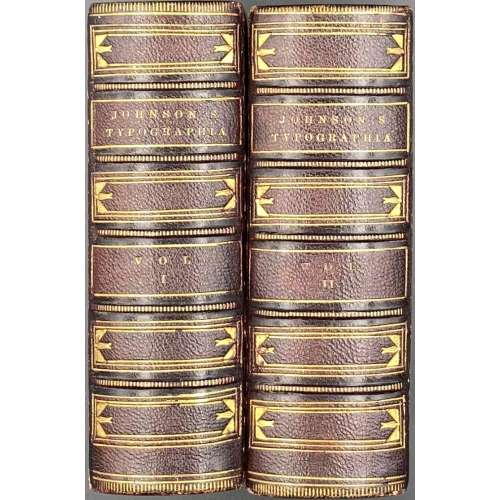 2 volume set, ¾ burgundy morocco over peacock marbled boards, ruled gilt, raised bands, gilt-ruled in compartments, gilt lettering, marbled endpapers and all margins, binding by W. S. Hiltz, NY. Vol. 1. Title: Typographia, | OR THE | Printers' Instructor: | INCLUDING AN ACCOUNT | of the | ORIGIN OF PRINTING, | with | Biographical Notices of the Printers of | England, from Caxton to the close | of the Sixteenth Century : | A Series of | Ancient and Modern Alphabets, | and | DOMESDAY CHARACTERS: | Together with | An Elucidation of every Subject con- | nected with the Art. | By J. JOHNSON, Printer. |{stanza}| Vol. I. | In frame: Published by Messrs. Longman, Hurst, | Rees, Orme, Brown & Green, Pater- | noster Row, London | Under the frame: 1824. || Pagination: Blank leaf, [2] – blank / engraved frontispiece (portrait of William Caxton by W. Hughes) w/guard, [2] – engraved t.p. by Thompson (upper margin almost none, tall lower margin, unframed) / blank, letterpress t.p. w/guard / blank, [2] – dedication to Earl Spenser and Roxburghe Club members / list of members, [2] – engraved Roxburgh Club plate by W. Hughes / blank, [4] – the pedigree of Earl Spenser, [i] ii-xii preface, [1] 2-610, [10] – index, blank leaf; printed on wove paper, text within double rule border. Vol. 2. Title: Typographia, | OR THE | Printers' Instructor: | INCLUDING AN ACCOUNT | of the | ORIGIN OF PRINTING, | with | Biographical Notices of the Printers of | England, from Caxton to the close | of the Sixteenth Century : | A Series of | Ancient and Modern Alphabets, | and | DOMESDAY CHARACTERS: | Together with | An Elucidation of every Subject con- | nected with the Art. | By J. JOHNSON, Printer. |{stanza}| Vol. II. | In frame: Published by Messrs. Longman, Hurst, | Rees, Orme, Brown & Green, Pater- | noster Row, London | Under the frame: 1824. || Pagination: Blank leaf, [2] – blank / engraved frontispiece (portrait of John Johnson ÆTATIS XLVI by William Harvey), w/o guard, [2] – engraved t.p. by G. W. Bonner (framed) / blank, letterpress t.p. w/o guard / blank, [2] – advert. / explanation of engraved title, [i]-iv contents, [1, 2] 3-663 [664], [14] – index, [2] – cantata, blank leaf; printed on wove paper, text within double rule border. Note: This is the book that served as a source of plagiarism for Adams's Typographia: a brief sketch of the origin, rise, and progress of the typographic art published in Philadelphia by himself in 1837.
2 volume set, ¾ burgundy morocco over peacock marbled boards, ruled gilt, raised bands, gilt-ruled in compartments, gilt lettering, marbled endpapers and all margins, binding by W. S. Hiltz, NY. Vol. 1. Title: Typographia, | OR THE | Printers' Instructor: | INCLUDING AN ACCOUNT | of the | ORIGIN OF PRINTING, | with | Biographical Notices of the Printers of | England, from Caxton to the close | of the Sixteenth Century : | A Series of | Ancient and Modern Alphabets, | and | DOMESDAY CHARACTERS: | Together with | An Elucidation of every Subject con- | nected with the Art. | By J. JOHNSON, Printer. |{stanza}| Vol. I. | In frame: Published by Messrs. Longman, Hurst, | Rees, Orme, Brown & Green, Pater- | noster Row, London | Under the frame: 1824. || Pagination: Blank leaf, [2] – blank / engraved frontispiece (portrait of William Caxton by W. Hughes) w/guard, [2] – engraved t.p. by Thompson (upper margin almost none, tall lower margin, unframed) / blank, letterpress t.p. w/guard / blank, [2] – dedication to Earl Spenser and Roxburghe Club members / list of members, [2] – engraved Roxburgh Club plate by W. Hughes / blank, [4] – the pedigree of Earl Spenser, [i] ii-xii preface, [1] 2-610, [10] – index, blank leaf; printed on wove paper, text within double rule border. Vol. 2. Title: Typographia, | OR THE | Printers' Instructor: | INCLUDING AN ACCOUNT | of the | ORIGIN OF PRINTING, | with | Biographical Notices of the Printers of | England, from Caxton to the close | of the Sixteenth Century : | A Series of | Ancient and Modern Alphabets, | and | DOMESDAY CHARACTERS: | Together with | An Elucidation of every Subject con- | nected with the Art. | By J. JOHNSON, Printer. |{stanza}| Vol. II. | In frame: Published by Messrs. Longman, Hurst, | Rees, Orme, Brown & Green, Pater- | noster Row, London | Under the frame: 1824. || Pagination: Blank leaf, [2] – blank / engraved frontispiece (portrait of John Johnson ÆTATIS XLVI by William Harvey), w/o guard, [2] – engraved t.p. by G. W. Bonner (framed) / blank, letterpress t.p. w/o guard / blank, [2] – advert. / explanation of engraved title, [i]-iv contents, [1, 2] 3-663 [664], [14] – index, [2] – cantata, blank leaf; printed on wove paper, text within double rule border. Note: This is the book that served as a source of plagiarism for Adams's Typographia: a brief sketch of the origin, rise, and progress of the typographic art published in Philadelphia by himself in 1837. -
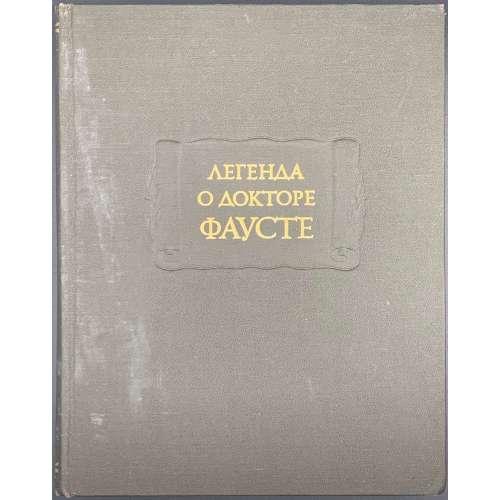 Title (black lettering, red elements): ЛЕГЕНДА | О ДОКТОРЕ | ФАУСТЕ | {element} | ИЗДАНИЕ ПОДГОТОВИЛ | В. М. ЖИРМУНСКИЙ | ВТОРОЕ, ИСПРАВЛЕННОЕ ИЗДАНИЕ | ИЗДАТЕЛЬСТВО «НАУКА» | МОСКВА 1978 || Pagination:[1-5] 6-421 [3]; +3 leaves of plates. Collation: 8vo; [1]8 2-278. Binding: 22 x 17.5 cm, serial green buckram blind-stamped with a scroll adorned with gold lettering to board and spine. Contents:
Title (black lettering, red elements): ЛЕГЕНДА | О ДОКТОРЕ | ФАУСТЕ | {element} | ИЗДАНИЕ ПОДГОТОВИЛ | В. М. ЖИРМУНСКИЙ | ВТОРОЕ, ИСПРАВЛЕННОЕ ИЗДАНИЕ | ИЗДАТЕЛЬСТВО «НАУКА» | МОСКВА 1978 || Pagination:[1-5] 6-421 [3]; +3 leaves of plates. Collation: 8vo; [1]8 2-278. Binding: 22 x 17.5 cm, serial green buckram blind-stamped with a scroll adorned with gold lettering to board and spine. Contents:- Исторические и легендарные свидетельства о докторе Фаусте / Пер. С. А. Акулянц.
- Народная книга: История о докторе Иоганне Фаусте, знаменитом чародее и чернокнижнике / Пер. Р. В. Френкель.
- Свидетельства о постановке народной драмы и кукольной комедии / Пер. С. А. Акулянц
- Кукольные комедии / Пер. H. A. Сигал: (1) Доктор Иоганн Фауст; (2) Доктор Фауст, или Великий Негромант; (3) Иоганнес Фауст.
- Кристофер Марло. Трагическая история доктора Фауста / Пер. H. H. Амосовой.
- «Фауст» Лессинга / Пер. В. Е. Гаккель-Аренс.
- Комментарии: В. М. Жирмунский. История легенды о Фаусте.
- Примечания / Сост. В. М. Жирмунский; к «Фаусту» Марло — H. H. Амосова.
-
![Юрий Масанов. В мире псевдонимов, анонимов и литературных подделок. / Под ред. и с вступ. ст. П. Н. Беркова. (Серия: Историко-литературные и биографические очерки). – М.: Издательство Всесоюзной книжной палаты, 1963. – pp.: [1-6] 7-318 [2], errata slip.](https://varshavskycollection.com/wp-content/uploads/2021/02/LIB-1589.2018-a-500x500.jpeg) Title: Ю. И. МАСАНОВ | В МИРЕ | ПСЕВДОНИМОВ, | АНОНИМОВ | И ЛИТЕРАТУРНЫХ | ПОДДЕЛОК | Под редакцией и со вступительной статьей | П. Н. БЕРКОВА | ИЗДАТЕЛЬСТВО ВСЕСОЮЗНОЙ КНИЖНОЙ ПАЛАТЫ | МОСКВА • 1963 || Frontispiece: ИСТОРИКО- | ЛИТЕРАТУРНЫЕ | И | БИОГРАФИЧЕСКИЕ | ОЧЕРКИ Pagination: [1-6] 7-318 [2], errata slip; 15 leaves of plates. Collation: 8vo; [1]8 2-208. Binding: 22.0 x 18 cm, hardcover; publisher's tan cloth, gilt arabesque to front board, brown labels with gilt lettering to spine; pictorial DJ. Масанов, Юрий Иванович (Russian, 1911 – 1965). Берков, Павел Наумович (Russian, (1896 – 1969).
Title: Ю. И. МАСАНОВ | В МИРЕ | ПСЕВДОНИМОВ, | АНОНИМОВ | И ЛИТЕРАТУРНЫХ | ПОДДЕЛОК | Под редакцией и со вступительной статьей | П. Н. БЕРКОВА | ИЗДАТЕЛЬСТВО ВСЕСОЮЗНОЙ КНИЖНОЙ ПАЛАТЫ | МОСКВА • 1963 || Frontispiece: ИСТОРИКО- | ЛИТЕРАТУРНЫЕ | И | БИОГРАФИЧЕСКИЕ | ОЧЕРКИ Pagination: [1-6] 7-318 [2], errata slip; 15 leaves of plates. Collation: 8vo; [1]8 2-208. Binding: 22.0 x 18 cm, hardcover; publisher's tan cloth, gilt arabesque to front board, brown labels with gilt lettering to spine; pictorial DJ. Масанов, Юрий Иванович (Russian, 1911 – 1965). Берков, Павел Наумович (Russian, (1896 – 1969). -
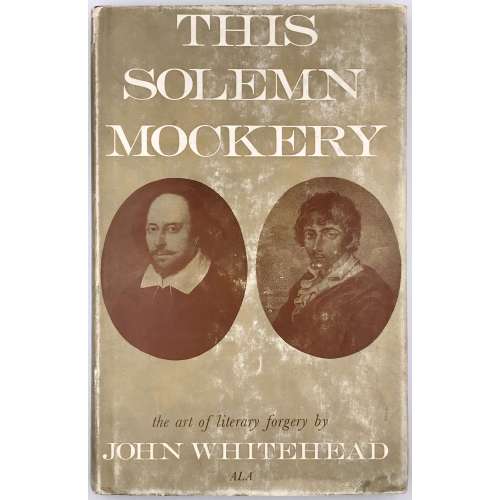 Title: This Solemn | Mockery | THE ART OF LITERARY FORGERY | John Whitehead, A.L.A. | Arlington Books {device} London Pagination: [2] – h.t. / blank, [2] – t.p. / imprint, [2] –contents / acknowledgement, 1-177 [178 blank]; 4 leaves of plates (total 96 leaves). Binding: 22.2 x 14.2 cm; hardcover, aubergine cloth, silver lettering to spine, pictorial dust jacket. ISBN-10: 0851402127
Title: This Solemn | Mockery | THE ART OF LITERARY FORGERY | John Whitehead, A.L.A. | Arlington Books {device} London Pagination: [2] – h.t. / blank, [2] – t.p. / imprint, [2] –contents / acknowledgement, 1-177 [178 blank]; 4 leaves of plates (total 96 leaves). Binding: 22.2 x 14.2 cm; hardcover, aubergine cloth, silver lettering to spine, pictorial dust jacket. ISBN-10: 0851402127 -
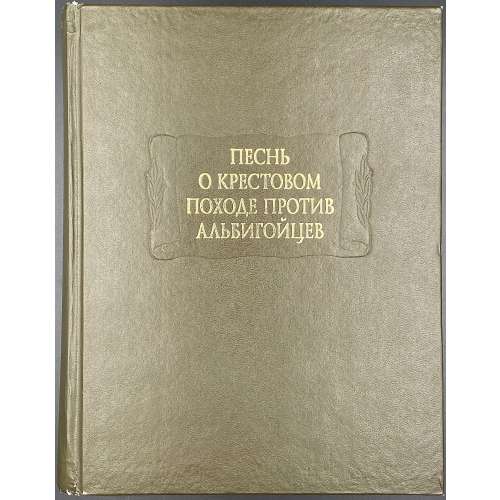 Title (black and red): ПЕСНЬ | О КРЕСТОВОМ | ПОХОДЕ ПРОТИВ | АЛЬБИГОЙЦЕВ | {device} | Издание подготовили | И.О. БЕЛАВИН, Е.В. МОРОЗОВА | Научно-издательский центр | «Ладомир» | «Наука» | Москва || Frontispiece (black and red): LA CHANSON DE | LA CROISADE | ALBIGEOISE | {device} || Pagination : [1-9] 10-437 [3] ; 79 illustr. on 20 leaves of colour plates between pp. 224/225, inset: folding double-sided map of the Albigensian Crusade43 x 64 cm; print run 2,000 copies. Binding: serial green buckram blind-stamped with a scroll adorned with gold lettering to board and spine. Отв. ред. М. Л. Андреев. Ред. изд-ва Л. А. Сифурова.
Title (black and red): ПЕСНЬ | О КРЕСТОВОМ | ПОХОДЕ ПРОТИВ | АЛЬБИГОЙЦЕВ | {device} | Издание подготовили | И.О. БЕЛАВИН, Е.В. МОРОЗОВА | Научно-издательский центр | «Ладомир» | «Наука» | Москва || Frontispiece (black and red): LA CHANSON DE | LA CROISADE | ALBIGEOISE | {device} || Pagination : [1-9] 10-437 [3] ; 79 illustr. on 20 leaves of colour plates between pp. 224/225, inset: folding double-sided map of the Albigensian Crusade43 x 64 cm; print run 2,000 copies. Binding: serial green buckram blind-stamped with a scroll adorned with gold lettering to board and spine. Отв. ред. М. Л. Андреев. Ред. изд-ва Л. А. Сифурова. -
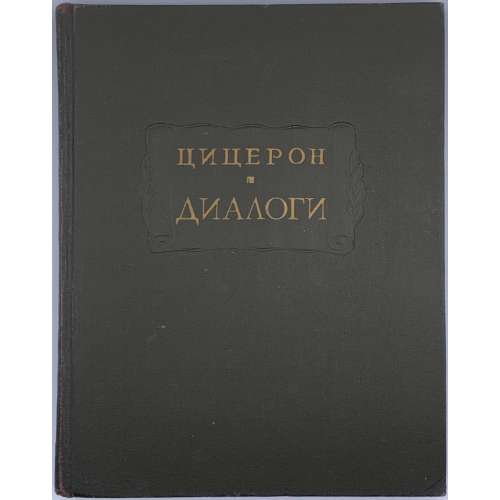 Title (black and red): ЦИЦЕРОН | ДИАЛОГИ | О ГОСУДАРСТВЕ 〜 О ЗАКОНАХ | ИЗДАНИЕ ПОДГОТОВИЛИ | И. Н. ВЕСЕЛОВСКИЙ, В. О. ГОРЕНШТЕЙН | и С. Л. УТЧЕНКО | {device} | ИЗДАТЕЛЬСТВО • НАУКА | МОСКВА • 1966 || Frontispiece (black and red): M. TVLLI CICERONIS | DIALOGI | DE REPUBLICA 〜 DE LEGIBUS| {device} || Pagination: [1-7] 8-223 [224], insert errata slip, 2 plates. Collation: 8vo; [1]8 2-148. Binding: 22 x 17.3 cm; hardbound: original serial green cloth, blind-stamped with scrolls and gilt lettering to board and spine, lacking DJ. Веселовский, Иван Николаевич (Russian, 1892 – 1977); Горенштейн, Виктор Осипович (Russian, 20th century); Утченко, Сергей Львович (Russian, 1908 – 1976).
Title (black and red): ЦИЦЕРОН | ДИАЛОГИ | О ГОСУДАРСТВЕ 〜 О ЗАКОНАХ | ИЗДАНИЕ ПОДГОТОВИЛИ | И. Н. ВЕСЕЛОВСКИЙ, В. О. ГОРЕНШТЕЙН | и С. Л. УТЧЕНКО | {device} | ИЗДАТЕЛЬСТВО • НАУКА | МОСКВА • 1966 || Frontispiece (black and red): M. TVLLI CICERONIS | DIALOGI | DE REPUBLICA 〜 DE LEGIBUS| {device} || Pagination: [1-7] 8-223 [224], insert errata slip, 2 plates. Collation: 8vo; [1]8 2-148. Binding: 22 x 17.3 cm; hardbound: original serial green cloth, blind-stamped with scrolls and gilt lettering to board and spine, lacking DJ. Веселовский, Иван Николаевич (Russian, 1892 – 1977); Горенштейн, Виктор Осипович (Russian, 20th century); Утченко, Сергей Львович (Russian, 1908 – 1976). -
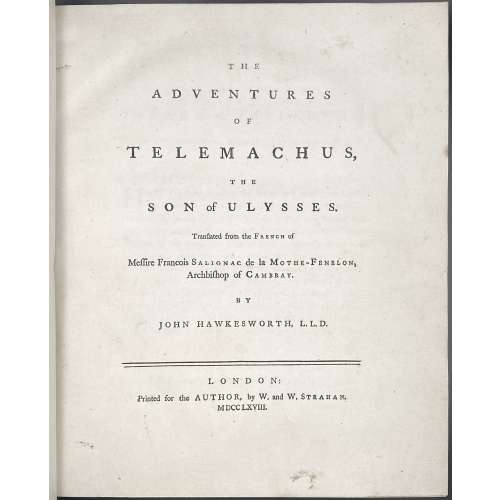 THE | ADVENTURES | OF | TELEMACHUS, | THE SON OF ULYSSES. | Translated from the French of | Messire François Salignac de la Mothe–Fenelon, | Archbishop of Cambray. | BY | JOHN HAWKESWORTH, L. L. D. | — | LONDON: | Printed for the AUTHOR, by W. and W. Strahan, | M DCC LXVIII. || Binding: half polished brown calf over marbled boards, wave ruled blind, gilt fillet ruled compartments, black label with gilt lettering to spine; 29.5 x 24.5 cm; marbled endpapers. Pagination: 2 blank leaves (wove paper), [I, ii] – t.p. / blank, [iii] iv – dedication, [v] vi-xv – subscribers, [xvi] blank, [xvii] xviii-xix – preface, [xx] xxi-xxxv – contents, [xxxvi] – errata, subscribers omitted, [1] 2-462, printed on laid paper, 2 blank leaves (wove paper). Collation: 4to; A4, a-c4 d2, B-Z4 Aa-Zz4 Aaa-Mmm4 Nnn3; 24 head- and 24 tailpieces engraved by Charles Grignion the Elder (British, 1721 – 1810) after Samuel Waly (British, 1720 – 1786). Original: François Fénelon. Les Aventures de Télémaque, fils d’Ulysse. See № LIB-2522-2020 in this collection. Not in Lewine, 1898; Not in Cohen De Ricci, 1912.
THE | ADVENTURES | OF | TELEMACHUS, | THE SON OF ULYSSES. | Translated from the French of | Messire François Salignac de la Mothe–Fenelon, | Archbishop of Cambray. | BY | JOHN HAWKESWORTH, L. L. D. | — | LONDON: | Printed for the AUTHOR, by W. and W. Strahan, | M DCC LXVIII. || Binding: half polished brown calf over marbled boards, wave ruled blind, gilt fillet ruled compartments, black label with gilt lettering to spine; 29.5 x 24.5 cm; marbled endpapers. Pagination: 2 blank leaves (wove paper), [I, ii] – t.p. / blank, [iii] iv – dedication, [v] vi-xv – subscribers, [xvi] blank, [xvii] xviii-xix – preface, [xx] xxi-xxxv – contents, [xxxvi] – errata, subscribers omitted, [1] 2-462, printed on laid paper, 2 blank leaves (wove paper). Collation: 4to; A4, a-c4 d2, B-Z4 Aa-Zz4 Aaa-Mmm4 Nnn3; 24 head- and 24 tailpieces engraved by Charles Grignion the Elder (British, 1721 – 1810) after Samuel Waly (British, 1720 – 1786). Original: François Fénelon. Les Aventures de Télémaque, fils d’Ulysse. See № LIB-2522-2020 in this collection. Not in Lewine, 1898; Not in Cohen De Ricci, 1912. -
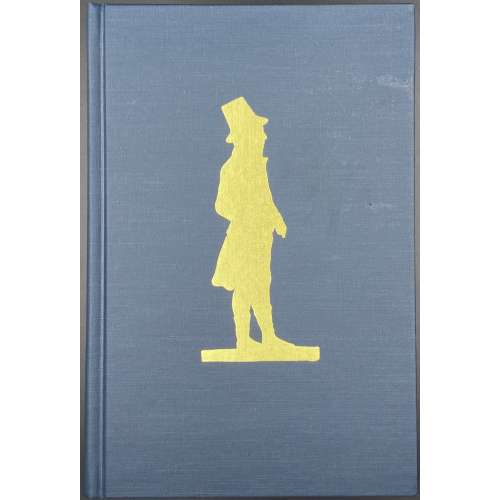 Title: THOMAS FROGNALL DIBDIN | 1776-1847 | A Bibliography | By John Windle and Karma Pippin | Oak Knoll Press | New Castle Delaware | 1999 || Pagination: [2 blanks] [i, ii] – standing silhouette / frontis. with buste portrait 1821 (misspelled "Didbin"), [iii, iv] – t.p. / colophon, [v, vi] – dedication / blank, [vii, viii] – contents / blank, [ix, x] – illustr. / portrait 1816, [xi] xii-xxiii [xxiv] [1] 2-284 [2]. Binding: 23.5 x 16 cm, hardcover, publisher’s blue cloth gilt-stamped with a standing silhouette of T. F. Dibdin to cover, gilt lettering to spine.
Title: THOMAS FROGNALL DIBDIN | 1776-1847 | A Bibliography | By John Windle and Karma Pippin | Oak Knoll Press | New Castle Delaware | 1999 || Pagination: [2 blanks] [i, ii] – standing silhouette / frontis. with buste portrait 1821 (misspelled "Didbin"), [iii, iv] – t.p. / colophon, [v, vi] – dedication / blank, [vii, viii] – contents / blank, [ix, x] – illustr. / portrait 1816, [xi] xii-xxiii [xxiv] [1] 2-284 [2]. Binding: 23.5 x 16 cm, hardcover, publisher’s blue cloth gilt-stamped with a standing silhouette of T. F. Dibdin to cover, gilt lettering to spine. -
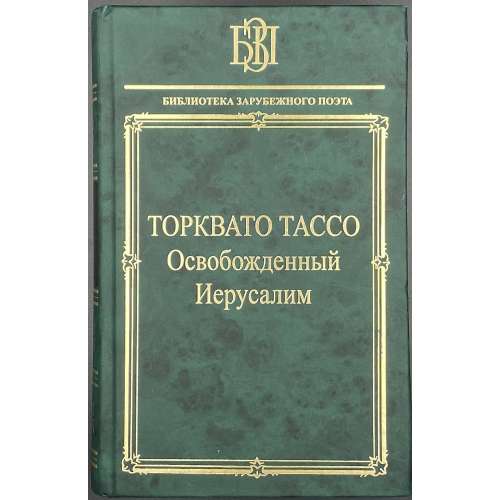 Hardcover, green publisher's paper boards, gilt lettering in the figural frame, black label with gilt lettering and gilt in compartments to spine. 21 x 13.5 cm, print run 2,500. pp.: [4] 5-714 [715/6] [4]. Title: ТОРКВАТО ТАССО | Освобожденный | Иерусалим | Перевод с итальянского | В. С. ЛИХАЧЕВА | Подготовка текста, предисловие, комментарии | А. О. ДЁМИНА | {publisher's device} | Санкт-Петербург | «НАУКА» | 2007 || ISBN 978-5-02-026954-5 Original: Torquato Tasso. La Gierusalemme Liberata.
Hardcover, green publisher's paper boards, gilt lettering in the figural frame, black label with gilt lettering and gilt in compartments to spine. 21 x 13.5 cm, print run 2,500. pp.: [4] 5-714 [715/6] [4]. Title: ТОРКВАТО ТАССО | Освобожденный | Иерусалим | Перевод с итальянского | В. С. ЛИХАЧЕВА | Подготовка текста, предисловие, комментарии | А. О. ДЁМИНА | {publisher's device} | Санкт-Петербург | «НАУКА» | 2007 || ISBN 978-5-02-026954-5 Original: Torquato Tasso. La Gierusalemme Liberata. -
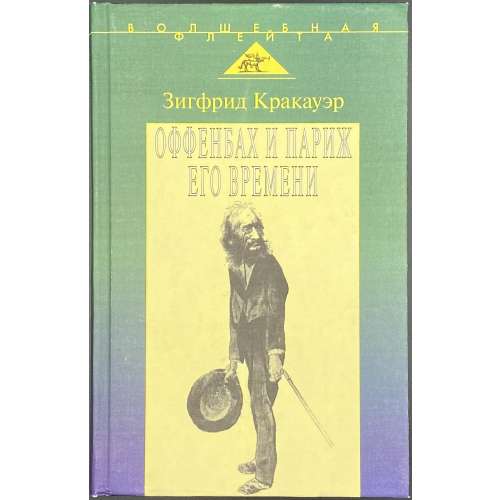 Hardcover, 21.5 x 13.5 cm, pictorial boards, [1-4] 5-412 [2] [2]. Print run 3,000. Translation from German of the original {Siegfried Krakauer. Jacques Offenbach und das Paris seiner Zeit. — Amsterdam: Allert de Lange, 1937} by Serafima Shlapoberskaya – Шлапоберская, Серафима Евгеньевна (Russian, 1921 – 2007).
Hardcover, 21.5 x 13.5 cm, pictorial boards, [1-4] 5-412 [2] [2]. Print run 3,000. Translation from German of the original {Siegfried Krakauer. Jacques Offenbach und das Paris seiner Zeit. — Amsterdam: Allert de Lange, 1937} by Serafima Shlapoberskaya – Шлапоберская, Серафима Евгеньевна (Russian, 1921 – 2007). -
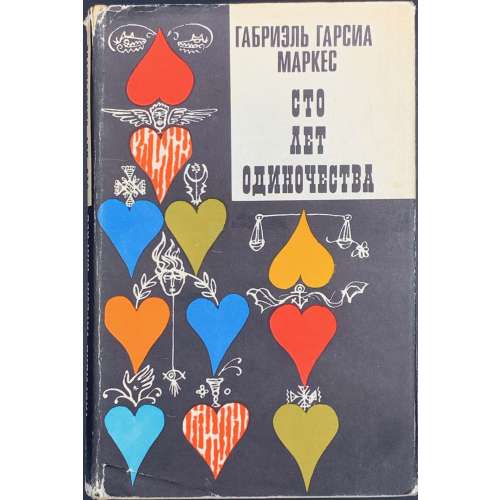 Hardcover, publisher's white cloth with a black imprint to cover, red and black lettering to spine, pictorial DJ, pp.: [1-4] 5-398 [2]. Послесловие В. Столбова, художник В. Юрлов. Russian translation of Cien años de soledad by Gabriel García Márquez.
Hardcover, publisher's white cloth with a black imprint to cover, red and black lettering to spine, pictorial DJ, pp.: [1-4] 5-398 [2]. Послесловие В. Столбова, художник В. Юрлов. Russian translation of Cien años de soledad by Gabriel García Márquez. -
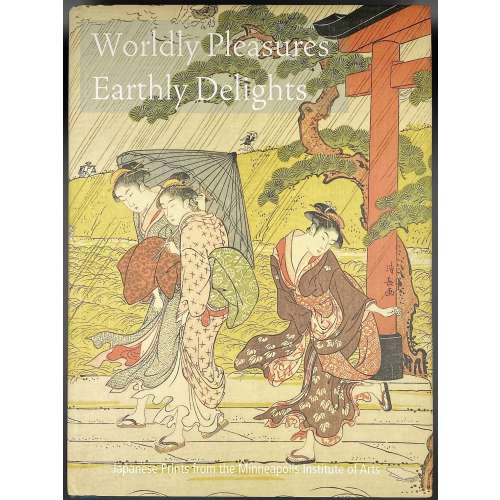 Hardcover, 32 x 23.5 cm, publisher's blue cloth, blind-stamped to cover, gilt lettering to spine, pictorial DJ; pp.: [1-6] 7-375 [376 blank], ill.
Hardcover, 32 x 23.5 cm, publisher's blue cloth, blind-stamped to cover, gilt lettering to spine, pictorial DJ; pp.: [1-6] 7-375 [376 blank], ill.This catalogue features the top ten percent of the collection ... presented in an exhibition ['Great ukiyo-e masters : common pleasures, uncommon prints : Japanese woodcuts from the Minneapolis Institute of Arts', sponsored by Asano Laboratories] that opened in Tokyo at the Shoto Museum of Art on October 2, 2007, and traveled to the Nara Prefectural Museum of Art and the Sanritz Hattori Museum of Arts"--Foreword. "This [2011] publication ... coincides with a special exhibition, 'Edo Pop: Japanese Master Prints from the Minneapolis Institute of Arts' (October 16, 2011, through January 8, 2012), which will [also] be shown at the High Museum of Art in Atlanta ..."--Foreword. "With contributions by Shūgō Asano, Akane Fujisawa, Murasaki Fujisawa, Yuriko Iwakiri, Yōsuke Katō, Junko Mutō, Noriko Yamamoto. Contents: Foreword / Kaywin Feldman Acknowledgments / Matthew Welch, Yuiko Kimura-Tilford Seductive beauty : coveting and collecting Ukiyo-e / Matthew Welch Time line of the artists Catalogue of selected prints Object list in English and Japanese
-
 Hardcover, 30 x 26 cm, publisher's pictorial boards, pp.: [1-5] 6-168, il.
Hardcover, 30 x 26 cm, publisher's pictorial boards, pp.: [1-5] 6-168, il.Published to accompany the recent successful exhibition at the Museu Picasso, Barcelona, this book sheds new light on Picasso's work - his connection with Japanese art. It is illustrated with images
-
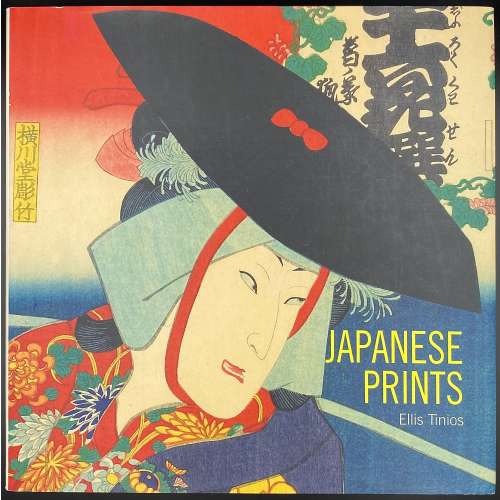 Hardcover, 23.5 x 23.5 cm, publisher's navy cloth, gilt-stamped lettering to spine, pictorial DJ; pp.: [1-6] 7-143 [144 blank].
Hardcover, 23.5 x 23.5 cm, publisher's navy cloth, gilt-stamped lettering to spine, pictorial DJ; pp.: [1-6] 7-143 [144 blank].Japanese woodblock prints of the Edo period (1615-1868) were the products of a highly commercialised and competitive publishing industry. Their content was inspired by the vibrant popular culture that flourished in Edo (Tokyo). At any given time scores of publishers competed for the services of the leading artists of the day. Publishers and artists displayed tremendous ingenuity in finding ways to sustain demand for prints and to circumvent the restrictions placed on the industry through government censorship. Although Japanese prints have long been appreciated in the West for their graphic qualities, their content has not always been fully understood. This book draws on recent scholarship that makes possible a more subtle appreciation of the imagery encountered in the prints and how they would have been read when first made. Through stunning new photography of both well-known and rarely published works in the collection of the British Museum, including many recent acquisitions, the author explores how and why such prints were made, providing a fascinating introduction to a much-loved but little-understood art form.
-
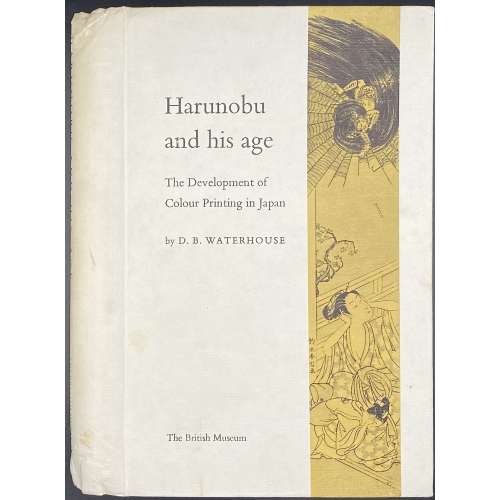
Pictorial cloth boards, spiral-bound, pp.: 3 leaves: h.t., frontis., t.p., 1-326; 123 black & white plates within the pagination.
-
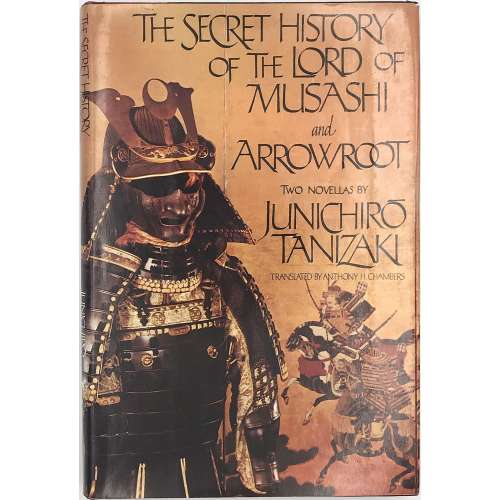 Hardcover, 22 x 15 cm; publisher's quarter burgundy cloth, gilt lettering to cover and spine, pictorial DJ. Stated 1st edition. Translation of Bushōkō Hiwa (The Secret History of the Lord of Musashi) and Yoshino Kuzu (Arrowroot). ISBN: 9780394524542
Hardcover, 22 x 15 cm; publisher's quarter burgundy cloth, gilt lettering to cover and spine, pictorial DJ. Stated 1st edition. Translation of Bushōkō Hiwa (The Secret History of the Lord of Musashi) and Yoshino Kuzu (Arrowroot). ISBN: 9780394524542 -
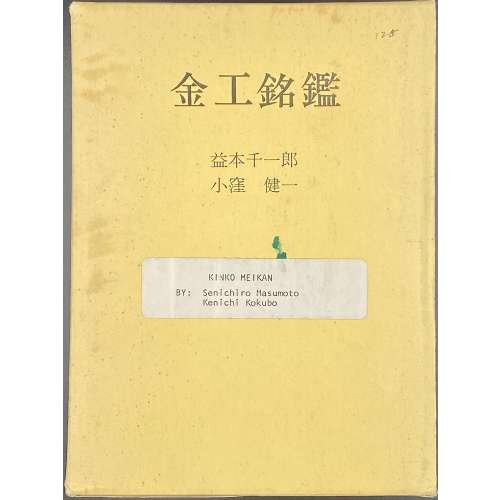 Publisher's brown cloth stamped in gilt, in a slipcase, 19 x 14 cm; pp.: [11] 1-657 [1] 1-12 [6]; in Japanese. With full English translation published in 1982 on letter-size writing paper in a separate folder, 29.5 x 23 cm, pp. [2] i-iii, 1-197, 1-52, 1-3. "Kinkō Meikan is a collection of photographs of signatures that appear on the tsuba and other fittings of the Japanese sword".
Publisher's brown cloth stamped in gilt, in a slipcase, 19 x 14 cm; pp.: [11] 1-657 [1] 1-12 [6]; in Japanese. With full English translation published in 1982 on letter-size writing paper in a separate folder, 29.5 x 23 cm, pp. [2] i-iii, 1-197, 1-52, 1-3. "Kinkō Meikan is a collection of photographs of signatures that appear on the tsuba and other fittings of the Japanese sword". -
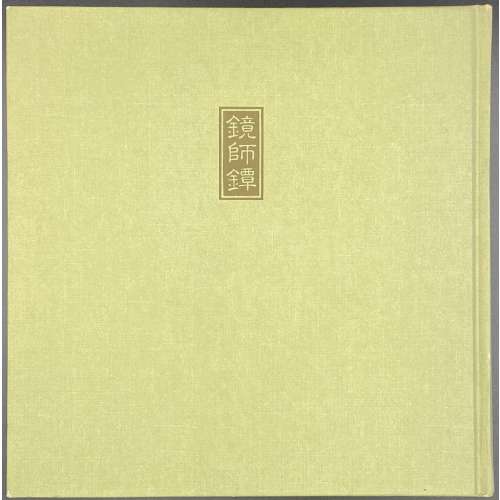 Japanese book: 24 leaves, 22 numbered plates, b/w photography reproduced photomechanically, with descriptions at the facing pages; in Japanese. Hardcover, 19 x 18.5 cm, green cloth stamped with title to front board and spine. Separate translation into English.
Japanese book: 24 leaves, 22 numbered plates, b/w photography reproduced photomechanically, with descriptions at the facing pages; in Japanese. Hardcover, 19 x 18.5 cm, green cloth stamped with title to front board and spine. Separate translation into English. -
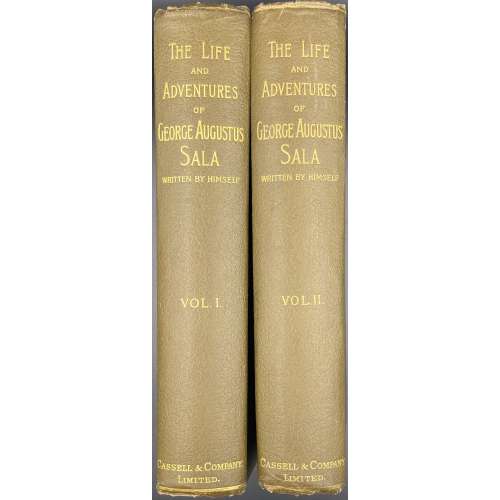 Vol. 1. Title: THE | LIFE AND ADVENTURES | OF | George Augustus Sala | WRITTEN BY HIMSELF | In Two Volumes | VOL. I. | (WITH PORTRAIT OF THE AUTHOR) | CASSEL AND COMPANY, Limited | LONDON, PARIS & MELBOURNE | 1895 | ALL RIGHTS RESERVED || Pagination: frontispiece portrait of Sala by Boussod, Valadon & Cie. w/guard tissue, [i, ii] – t.p./blank, [iii, iv] – dedication/blank, [v]-x – preface, [xi]-xvi – content, [1] 2-442, [16] advert. Collation: A-Z8 AA-BB8 CC5 [Advert.]8. Vol. 2. Title: THE | LIFE AND ADVENTURES | OF | George Augustus Sala | WRITTEN BY HIMSELF | In Two Volumes | VOL. II. | (WITH PORTRAIT OF THE AUTHORS MOTHER) | CASSEL AND COMPANY, Limited | LONDON, PARIS & MELBOURNE | 1895 | ALL RIGHTS RESERVED || Pagination: frontispiece portrait of Sal’s mother w/guard tissue, [i, ii] – t.p. / blank, [iii] iv-viii – content, [1] 2-457-[460], [16] advert. Collation: A-Z8 aa-cc8 dd6 [Advert.]8. Binding: two volumes in uniform green publisher’s pebbled buckram, gilt lettering to spine, contemporary newspaper clippings to front and back pastedowns, vol. 2 uncut. Note: George Augustus Sala's mother was an actress Henrietta Simon Sala, known as Madame Sala, (Guyanese, British, 1789 – 1860). Here she is depicted by an engraver Thomas Alfred Woolnoth (British, 1785 – 1857) after a portrait painted by Rose Emma Drummond (British, fl. 1820 – 1840).
Vol. 1. Title: THE | LIFE AND ADVENTURES | OF | George Augustus Sala | WRITTEN BY HIMSELF | In Two Volumes | VOL. I. | (WITH PORTRAIT OF THE AUTHOR) | CASSEL AND COMPANY, Limited | LONDON, PARIS & MELBOURNE | 1895 | ALL RIGHTS RESERVED || Pagination: frontispiece portrait of Sala by Boussod, Valadon & Cie. w/guard tissue, [i, ii] – t.p./blank, [iii, iv] – dedication/blank, [v]-x – preface, [xi]-xvi – content, [1] 2-442, [16] advert. Collation: A-Z8 AA-BB8 CC5 [Advert.]8. Vol. 2. Title: THE | LIFE AND ADVENTURES | OF | George Augustus Sala | WRITTEN BY HIMSELF | In Two Volumes | VOL. II. | (WITH PORTRAIT OF THE AUTHORS MOTHER) | CASSEL AND COMPANY, Limited | LONDON, PARIS & MELBOURNE | 1895 | ALL RIGHTS RESERVED || Pagination: frontispiece portrait of Sal’s mother w/guard tissue, [i, ii] – t.p. / blank, [iii] iv-viii – content, [1] 2-457-[460], [16] advert. Collation: A-Z8 aa-cc8 dd6 [Advert.]8. Binding: two volumes in uniform green publisher’s pebbled buckram, gilt lettering to spine, contemporary newspaper clippings to front and back pastedowns, vol. 2 uncut. Note: George Augustus Sala's mother was an actress Henrietta Simon Sala, known as Madame Sala, (Guyanese, British, 1789 – 1860). Here she is depicted by an engraver Thomas Alfred Woolnoth (British, 1785 – 1857) after a portrait painted by Rose Emma Drummond (British, fl. 1820 – 1840). -
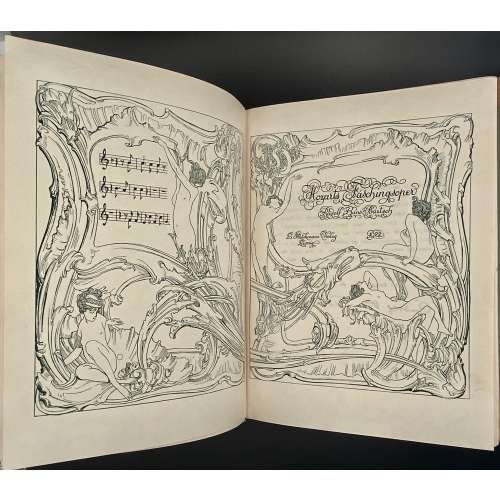 Of the limited edition of 1150 copies, this is №54 (on Japan paper, signed by Bartsch and by von Bayros). Owner's binding imitating quarter-morocco, a red label with gilt lettering to spine (possibly by Ms Hunt, who was an amateur bookbinder). Bookplate on front pastedown: "Ex libris Rachel McMasters Miller Hunt | S. B. Hill Dec 1913 | A.J. Downey Sc." Alfred James Downey (1882-1944). Rachel McMasters Miller Hunt (1882-1963). Sarah B. Hill had done lettering for Ms Hunt. On back pastedown: Stamp "Hunt Libraries CMU" and sticker "Gotham Book Mart | 128 West 45th street | New York". This is from an edition of Carcassonne:
Of the limited edition of 1150 copies, this is №54 (on Japan paper, signed by Bartsch and by von Bayros). Owner's binding imitating quarter-morocco, a red label with gilt lettering to spine (possibly by Ms Hunt, who was an amateur bookbinder). Bookplate on front pastedown: "Ex libris Rachel McMasters Miller Hunt | S. B. Hill Dec 1913 | A.J. Downey Sc." Alfred James Downey (1882-1944). Rachel McMasters Miller Hunt (1882-1963). Sarah B. Hill had done lettering for Ms Hunt. On back pastedown: Stamp "Hunt Libraries CMU" and sticker "Gotham Book Mart | 128 West 45th street | New York". This is from an edition of Carcassonne:
-
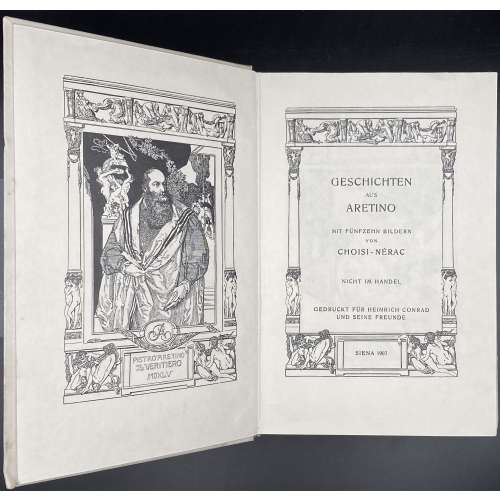 Title: GESCHICHTEN | AUS | ARETINO | MIT FÜNFZEHN BILDERN | VON | CHOISI-NÉRAC | NICHT IM HANDEL | GEDRUCKT FÜR HEINRICH CONRAD | UND SEINE FREUNDE | SIENA 1907 || Collation: 8vo; 1-128 137; frontispiece, t.p. and 14 plates, extraneous to collation. Pagination: [2] f.t. / blank, 3-203 [2], il. Binding: Full cream vellum, ruled with gilt double-fillet, grey label with gilt lettering to spine. Bookplate by von Bayros Par Avi Cigno to front pastedown. Note: Private edition of Aretino's Ragionamenti in German as Geschichten aus Aretino by translater and publisher Heinrich Conrad (German, 1866 – 1918), whose real name was Hugo Storm, this copy №394, illustrated by Franz von Bayros (Austrian, 1866 – of Choisi-Nérac.
Title: GESCHICHTEN | AUS | ARETINO | MIT FÜNFZEHN BILDERN | VON | CHOISI-NÉRAC | NICHT IM HANDEL | GEDRUCKT FÜR HEINRICH CONRAD | UND SEINE FREUNDE | SIENA 1907 || Collation: 8vo; 1-128 137; frontispiece, t.p. and 14 plates, extraneous to collation. Pagination: [2] f.t. / blank, 3-203 [2], il. Binding: Full cream vellum, ruled with gilt double-fillet, grey label with gilt lettering to spine. Bookplate by von Bayros Par Avi Cigno to front pastedown. Note: Private edition of Aretino's Ragionamenti in German as Geschichten aus Aretino by translater and publisher Heinrich Conrad (German, 1866 – 1918), whose real name was Hugo Storm, this copy №394, illustrated by Franz von Bayros (Austrian, 1866 – of Choisi-Nérac. -
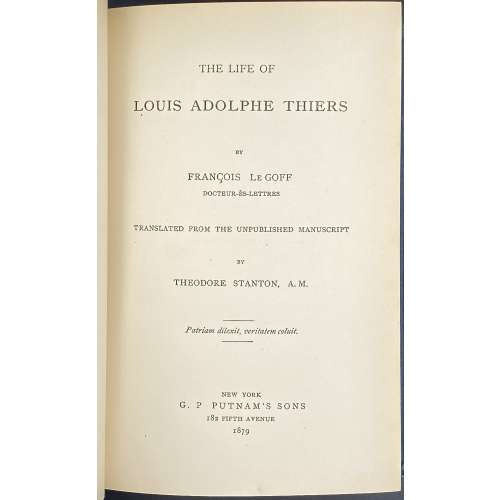 Title: THE LIFE OF LOUIS ADOLPHE THIERS | BY | FRANCOIS Le GOFF | DOCTEUR-ÈS-LETTRES | TRANSLATED FROM THE UNPUBLISHED MANUSCRIPT | BY | THEODORE STANTON, A. M. | {motto: Patriam dilexit, veritatem coluit.} | NEW YORK | G. P Putnam's Sons, 1879 | 182 FIFTH AVENUE | 1879 || Pagination: 2 blank leaves, frontis.: portrait of A. Thiers engraved on wood by J.I. Pease w/ tissue guard, [2] fac-simile of Thiers’s handwriting / blank, [2] - t.p. / copyright, [2] – dedication / blank, [2] – translators note / blank, [2] contents / blank, [vii] viii-xi [xii], [1] 2-353 [354 blank], [4] advert., 2 blank leaves; ill.: frontis., 1 woodcut plate, 1 folding manuscript fac-simile. Binding: dark-green cloth with bevelled margins, a gilt fac-simile of Thiers’s handwriting to front board, gilt lettering to spine. Note: The motto on the title page (Patriam dilexit, veritatem coluit) is taken from A. Thiers tomb on Père-Lachaise cemetery in Paris: "He cherished his homeland and worshipped the truth".
Title: THE LIFE OF LOUIS ADOLPHE THIERS | BY | FRANCOIS Le GOFF | DOCTEUR-ÈS-LETTRES | TRANSLATED FROM THE UNPUBLISHED MANUSCRIPT | BY | THEODORE STANTON, A. M. | {motto: Patriam dilexit, veritatem coluit.} | NEW YORK | G. P Putnam's Sons, 1879 | 182 FIFTH AVENUE | 1879 || Pagination: 2 blank leaves, frontis.: portrait of A. Thiers engraved on wood by J.I. Pease w/ tissue guard, [2] fac-simile of Thiers’s handwriting / blank, [2] - t.p. / copyright, [2] – dedication / blank, [2] – translators note / blank, [2] contents / blank, [vii] viii-xi [xii], [1] 2-353 [354 blank], [4] advert., 2 blank leaves; ill.: frontis., 1 woodcut plate, 1 folding manuscript fac-simile. Binding: dark-green cloth with bevelled margins, a gilt fac-simile of Thiers’s handwriting to front board, gilt lettering to spine. Note: The motto on the title page (Patriam dilexit, veritatem coluit) is taken from A. Thiers tomb on Père-Lachaise cemetery in Paris: "He cherished his homeland and worshipped the truth". -
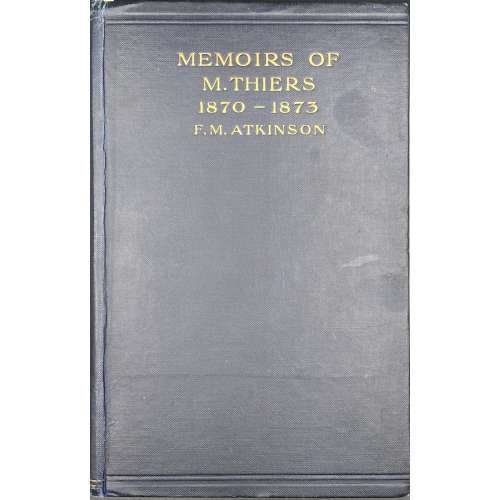 Title: MEMOIRS OF M. THIERS | 1870—1873 | Translated by | F. M. ATKINSON | {publisher’s device} | LONDON: GEORGE ALLEN & UNWIN LTD. | RUSKIN HOUSE 40 MUSEUM STREET, W.C. Pagination: [6] 7-384. Collation: 8vo; [1]-248. Size: 23 x 15 cm Binding: Blue cloth, top and bottom ruled in blind, gilt lettering to front cover and spine. Original: Adolphe Thiers. Notes et souvenirs de M. Thiers, 1870-1873: voyage diplomatique, proposition d'un armistice, préliminaires de la paix, présidence de la République. — Paris : [s.n.], 1901. — 465 p. The preface and editing signed "F. D." [Félicie Dosne]. Félicie Dosne (French, 1823 – 1906) was Thiers's sister-in-law.
Title: MEMOIRS OF M. THIERS | 1870—1873 | Translated by | F. M. ATKINSON | {publisher’s device} | LONDON: GEORGE ALLEN & UNWIN LTD. | RUSKIN HOUSE 40 MUSEUM STREET, W.C. Pagination: [6] 7-384. Collation: 8vo; [1]-248. Size: 23 x 15 cm Binding: Blue cloth, top and bottom ruled in blind, gilt lettering to front cover and spine. Original: Adolphe Thiers. Notes et souvenirs de M. Thiers, 1870-1873: voyage diplomatique, proposition d'un armistice, préliminaires de la paix, présidence de la République. — Paris : [s.n.], 1901. — 465 p. The preface and editing signed "F. D." [Félicie Dosne]. Félicie Dosne (French, 1823 – 1906) was Thiers's sister-in-law. -
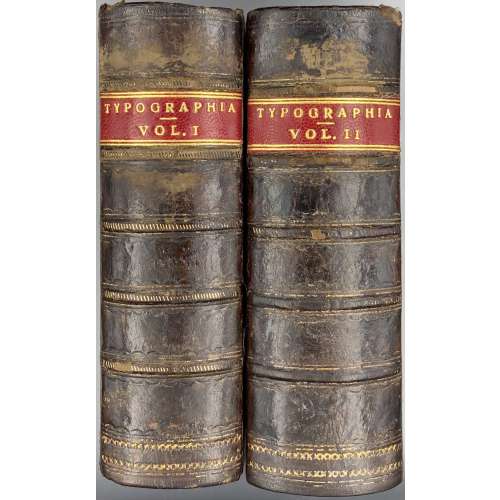 2 volume set. Vol. 1. Title: Typographia, | OR THE | Printers' Instructor : | INCLUDING AN ACCOUNT | of the | ORIGIN OF PRINTING, | with | Biographical Notices of the Printers of | England, from Caxton to the close | of the Sixteenth Century : | A Series of | Ancient and Modern Alphabets, | and | DOMESDAY CHARACTERS : | Together with | An Elucidation of every Subject con- | nected with the Art. | By J. JOHNSON, Printer. |{stanza}| Vol. I. | In frame: Published by Messrs. Longman, Hurst, | Rees, Orme, Brown & Green, Pater- | noster Row, London | Under the frame: 1824. || Typographical frame with the names of distinguished printers; on the cornerstone: William Caxton, 1474. Pagination: ffl / blank, blank / engraved frontis., engraved t.p. / blank, engraved dedication / list of club members, engraved arms vignette / blank, [4] pedigree, [i] ii-xii – preface, [1] 2-610, [10] – index, bfl. Text printed in the frame. To ffl : previous owner’s inscription: Herbert Heath | from | William Blades. | Xmas 1886; Frontispiece: Portrait of John Johnson at age 46, engraved on wood by W. Hughes; t.p.: TYPOGRAPHIA, | OR THE | PRINTERS INSTRUCTOR | BY | J.JOHNSON | PRINTER. VOL. 2. | 1824 | frame with lettering, top: GUTTnbg – FAUST – ELZEVIR – ALDUS, bottom: MENTZ – STRASbg –HARLAEM | below: BIBLIOTHECA • BODLEIANA. | below the frame: G.W.BONNER SC ||; Dedication to Earl Spenser, K. G., and the members of The Roxburghe Club, dated 1824, engraved on wood by W. Hughes; Arms vignette: Roxburghe Club | Instituted | June XVII | M D CCCXII || engraved on wood by William Harvey. Provenance: Admiral Sir Herbert Leopold Heath, KCB MVO (1861 – 1954); William Blades (1824 – 1890) – English printer and bibliographies. Inscription to ffl in both vols:D. Bateman. Vol. 2. Pagination: ffl, t.p. (similar lettering, but Vol. II.) / blank, [2] advert., [i] ii-iv contents, [1, 2] 3-663 [664] [16]. Points: Vol. 1.: Frontispiece portrait of Caxton replaced by a portrait of J. Johnson from Vol. 2, engraved t.p. of Vol. 1. replaced by t.p. of Vol. 2; Vol. 2 without engraved t.p., and without frontispiece. Edition: First Edition. Size: 16mo. 12.5 x 8.5 cm Binding: Mid-nineteenth century polished calf, the covers with a border of a gilt double fillet and blind roll. Spine divided into six panels with raised bands flanked with gilt fillets, lettered on new red goatskin labels, marbled endleaves and edges. Seller's description:
2 volume set. Vol. 1. Title: Typographia, | OR THE | Printers' Instructor : | INCLUDING AN ACCOUNT | of the | ORIGIN OF PRINTING, | with | Biographical Notices of the Printers of | England, from Caxton to the close | of the Sixteenth Century : | A Series of | Ancient and Modern Alphabets, | and | DOMESDAY CHARACTERS : | Together with | An Elucidation of every Subject con- | nected with the Art. | By J. JOHNSON, Printer. |{stanza}| Vol. I. | In frame: Published by Messrs. Longman, Hurst, | Rees, Orme, Brown & Green, Pater- | noster Row, London | Under the frame: 1824. || Typographical frame with the names of distinguished printers; on the cornerstone: William Caxton, 1474. Pagination: ffl / blank, blank / engraved frontis., engraved t.p. / blank, engraved dedication / list of club members, engraved arms vignette / blank, [4] pedigree, [i] ii-xii – preface, [1] 2-610, [10] – index, bfl. Text printed in the frame. To ffl : previous owner’s inscription: Herbert Heath | from | William Blades. | Xmas 1886; Frontispiece: Portrait of John Johnson at age 46, engraved on wood by W. Hughes; t.p.: TYPOGRAPHIA, | OR THE | PRINTERS INSTRUCTOR | BY | J.JOHNSON | PRINTER. VOL. 2. | 1824 | frame with lettering, top: GUTTnbg – FAUST – ELZEVIR – ALDUS, bottom: MENTZ – STRASbg –HARLAEM | below: BIBLIOTHECA • BODLEIANA. | below the frame: G.W.BONNER SC ||; Dedication to Earl Spenser, K. G., and the members of The Roxburghe Club, dated 1824, engraved on wood by W. Hughes; Arms vignette: Roxburghe Club | Instituted | June XVII | M D CCCXII || engraved on wood by William Harvey. Provenance: Admiral Sir Herbert Leopold Heath, KCB MVO (1861 – 1954); William Blades (1824 – 1890) – English printer and bibliographies. Inscription to ffl in both vols:D. Bateman. Vol. 2. Pagination: ffl, t.p. (similar lettering, but Vol. II.) / blank, [2] advert., [i] ii-iv contents, [1, 2] 3-663 [664] [16]. Points: Vol. 1.: Frontispiece portrait of Caxton replaced by a portrait of J. Johnson from Vol. 2, engraved t.p. of Vol. 1. replaced by t.p. of Vol. 2; Vol. 2 without engraved t.p., and without frontispiece. Edition: First Edition. Size: 16mo. 12.5 x 8.5 cm Binding: Mid-nineteenth century polished calf, the covers with a border of a gilt double fillet and blind roll. Spine divided into six panels with raised bands flanked with gilt fillets, lettered on new red goatskin labels, marbled endleaves and edges. Seller's description:John Johnson (1777-1848) operated Sir Samuel Egerton Brydges's Lee Priory Press before a falling-out. Typographia was printed at his Apollo Press, in Brook Street, Holborn, with the financial support of Edward Walmsley, and came out in four sizes. "Of the few standard works on the art of printing in the English language, this is perhaps the most familiar. [The first volume contains] a table of the introduction of the art into the different countries, after which comes the "introduction and art in Great Britain", with a list of the productions of the first printers up to 1599. The second volume may be described as practical, in contradistinction to the first, which is historical. It gives a description of types, directions for composing, for press, and warehouse work, &c. It is particularly rich in foreign alphabets, a feature which has gained of it great estimation. It has long since become, and deservedly, a printer's classic" - Bigmore & Wyman, I, pp.371-2.
Note: This is the book that served as a source of plagiarism for Adams's Typographia: a brief sketch of the origin, rise, and progress of the typographic art published in Philadelphia by himself in 1837. The copy returned to the seller for the reason stated in section Points above and replaced with the unaltered copy LIB-2693.2021. -
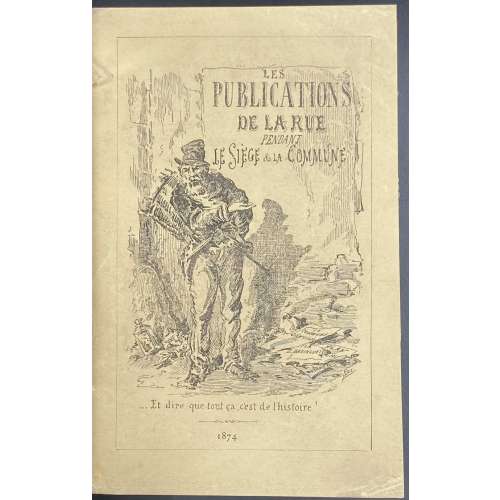 Convolute with three editions, dedicated to the Commune of Paris, 1871. (1) LES | Publications de la Rue | pendant | LE SIEGE ET LA COMMUNE | SATIRES — CANARDS — COMPLAINTES — CHANSONS | PLACARDS ET PAMPHLETS | BIBLIOGRAPHIE | PITTORESQUE ET ANECDOTIQUE | Par Firmin MAILLARD |{publisher’s device}| PARIS | AUGUSTE AUBRY, ÉDITEUR | 18, RUE SÉGUIER, 18 | 1874 || Pagination: ffl, original pictorial wrapper, [2] – blank / advert., [2] – h.t. / blank, [2] – h.t. / colophon imprim. PILLET FILS AINÉ, frontis. similar to front wrapper without '1874', [2] – t.p. / blank, [v] vi-xii, [1] 2-198, three blank leaves, back wrapper. (2) VILLE DE SAINT-DENIS | EXPOSITION D'ART & D'HISTOIRE | La Commune de Paris |18 Mars 1871 28 Mai | AVANT-PROPOS DE Lucien DESCAVES | de l’Académie Goncourt | PREFACE DE Jacques DORIOT | Député de la Seine, Maire de Saint-Denis | Du 17 Mars au 26 Mai 1935 | au Musée Municipal | 4, place de la Légion d’Honneur – Saint-Denis || Pagination: original pictorial wrapper in black and red, frontis., [2] - t.p. / blank, [2] – commité, v-xiii [xiv] 1-113 [114], 26 plates (13 leaves), blank back wrapper, spine tipped-in. (3) J. LEMONNYER | LES | JOURNAUX DE PARIS | PENDANT | LA COMMUNE | REVUE BIBLIOGRAPHIQUE COMPLETE | DE LA PRESSE PARISIENNE | du 19 Mars au 27 Mai | AVEC |{7 lines of text}| ET | UNE TABLE ALPHABÉTIQUE | DONNANT LE PRIX-COURANT DE CHAQUE COLLECTION | PARIS : J. LEMONNYER, Librarire | 73, Rue de Provence, 73 || Pagination: [2] - t.p. / blank, [2] – preface, [7] 8-94, green back wrapper w/advert., bfl. (lacks original front wrapper). Binding: Modern (20th century) red cloth, black label with gilt lettering to spine, matching marbled endpapers. Size: 18.5 x 13 cm; 12mo.
Convolute with three editions, dedicated to the Commune of Paris, 1871. (1) LES | Publications de la Rue | pendant | LE SIEGE ET LA COMMUNE | SATIRES — CANARDS — COMPLAINTES — CHANSONS | PLACARDS ET PAMPHLETS | BIBLIOGRAPHIE | PITTORESQUE ET ANECDOTIQUE | Par Firmin MAILLARD |{publisher’s device}| PARIS | AUGUSTE AUBRY, ÉDITEUR | 18, RUE SÉGUIER, 18 | 1874 || Pagination: ffl, original pictorial wrapper, [2] – blank / advert., [2] – h.t. / blank, [2] – h.t. / colophon imprim. PILLET FILS AINÉ, frontis. similar to front wrapper without '1874', [2] – t.p. / blank, [v] vi-xii, [1] 2-198, three blank leaves, back wrapper. (2) VILLE DE SAINT-DENIS | EXPOSITION D'ART & D'HISTOIRE | La Commune de Paris |18 Mars 1871 28 Mai | AVANT-PROPOS DE Lucien DESCAVES | de l’Académie Goncourt | PREFACE DE Jacques DORIOT | Député de la Seine, Maire de Saint-Denis | Du 17 Mars au 26 Mai 1935 | au Musée Municipal | 4, place de la Légion d’Honneur – Saint-Denis || Pagination: original pictorial wrapper in black and red, frontis., [2] - t.p. / blank, [2] – commité, v-xiii [xiv] 1-113 [114], 26 plates (13 leaves), blank back wrapper, spine tipped-in. (3) J. LEMONNYER | LES | JOURNAUX DE PARIS | PENDANT | LA COMMUNE | REVUE BIBLIOGRAPHIQUE COMPLETE | DE LA PRESSE PARISIENNE | du 19 Mars au 27 Mai | AVEC |{7 lines of text}| ET | UNE TABLE ALPHABÉTIQUE | DONNANT LE PRIX-COURANT DE CHAQUE COLLECTION | PARIS : J. LEMONNYER, Librarire | 73, Rue de Provence, 73 || Pagination: [2] - t.p. / blank, [2] – preface, [7] 8-94, green back wrapper w/advert., bfl. (lacks original front wrapper). Binding: Modern (20th century) red cloth, black label with gilt lettering to spine, matching marbled endpapers. Size: 18.5 x 13 cm; 12mo. -
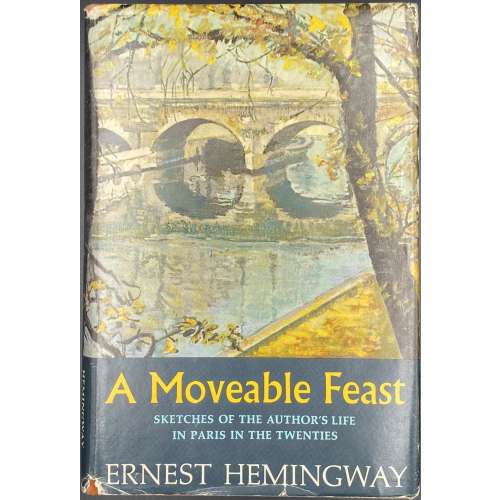 ERNEST HEMINGWAY | A Moveable Feast | {Citation} | CHARLES SCRIBNER'S SONS, | New York || Pagination: [12] – incl: advert., h.t., t.p., colophon, contents, preface, and note, [1, 2] - f.t. / blank, 3-211 [212]. Publisher’s cloth-backed stamped boards, original dust jacket. Ref.: Hanneman A31a.
ERNEST HEMINGWAY | A Moveable Feast | {Citation} | CHARLES SCRIBNER'S SONS, | New York || Pagination: [12] – incl: advert., h.t., t.p., colophon, contents, preface, and note, [1, 2] - f.t. / blank, 3-211 [212]. Publisher’s cloth-backed stamped boards, original dust jacket. Ref.: Hanneman A31a. -
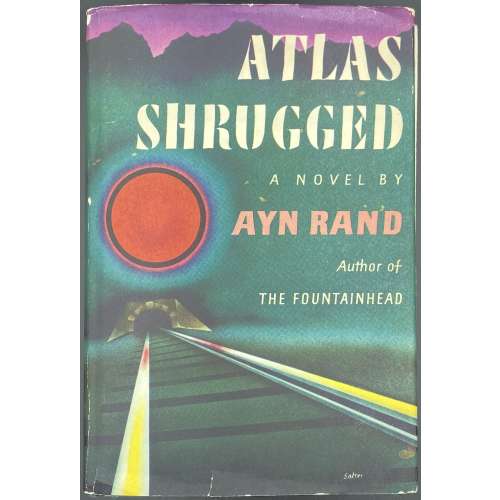 ATLAS | SHRUGGED | AYN RAND | {Publisher's device} | RANDOM HOUSE | NEW YORK || Pagination: [2] - h.t. / advert., [2] – t.p. / colophon, [2] – dedication / blank, [2] – contents / cont., [1, 2] ¬ f.t. / blank, [3] 4-1168 [1169] blank, [1170/71] about the author [1172] blank, two blank leaves. Original green cloth with gilt lettering, black label with gilt lettering and publisher device to spine; top margin green, lateral margin untrimmed. Stated first edition, first printing. Original dust jacket with $6.95 printed price and 10/57 code present on the front flap.
ATLAS | SHRUGGED | AYN RAND | {Publisher's device} | RANDOM HOUSE | NEW YORK || Pagination: [2] - h.t. / advert., [2] – t.p. / colophon, [2] – dedication / blank, [2] – contents / cont., [1, 2] ¬ f.t. / blank, [3] 4-1168 [1169] blank, [1170/71] about the author [1172] blank, two blank leaves. Original green cloth with gilt lettering, black label with gilt lettering and publisher device to spine; top margin green, lateral margin untrimmed. Stated first edition, first printing. Original dust jacket with $6.95 printed price and 10/57 code present on the front flap. -
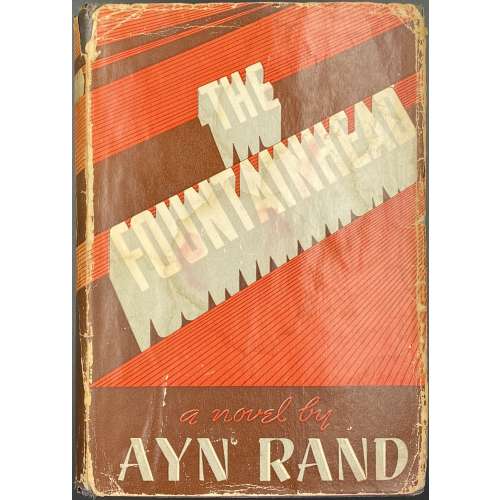 Description: Publisher’s blue cloth lettered in gilt to front cover and spine, spine darkened and rubbed at ends, upper joint starting, pictorial dust jacket with Ain Rand photograph portrait on the back, unclipped ($3,00). Title-page: The | FOUNTAINHEAD | By AYN RAND | THE BOBBS–MERRILL COMPANY, INC. | Publishers | INDIANAPOLIS {space} NEW YORK || Pagination: [1-6] 9-753 [754]. Edition: First edition, later printing; lacks "First edition" statement; blue cloth; photo on the back of DJ, p. 321 line 5 "referred", p. 480 "Domininque" twice.
Description: Publisher’s blue cloth lettered in gilt to front cover and spine, spine darkened and rubbed at ends, upper joint starting, pictorial dust jacket with Ain Rand photograph portrait on the back, unclipped ($3,00). Title-page: The | FOUNTAINHEAD | By AYN RAND | THE BOBBS–MERRILL COMPANY, INC. | Publishers | INDIANAPOLIS {space} NEW YORK || Pagination: [1-6] 9-753 [754]. Edition: First edition, later printing; lacks "First edition" statement; blue cloth; photo on the back of DJ, p. 321 line 5 "referred", p. 480 "Domininque" twice. -
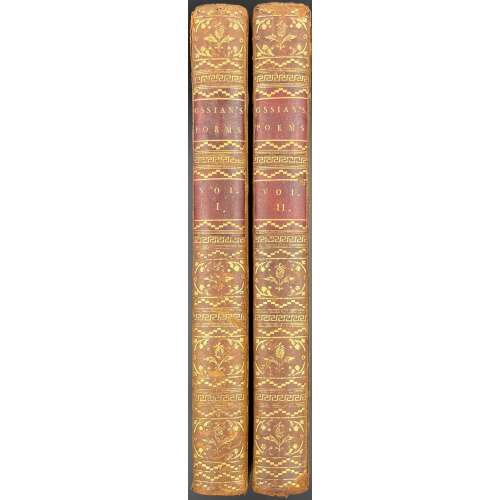 Vol. 1: THE | POEMS | OF | OSSIAN. | TRANSLATED | By JAMES MACPHERSON, Esq; | IN TWO VOLUMES. VOL. I. | A NEW EDITION. | LONDON: | PRINTED FOR W. STRAHAN ; AND T. CADELL, | IN THE STRAND. | M DCC XC.|| Pagination: 2 blank leaves, [2] - t.p. / blank, [v] vi-xiv, [2] - contents / cont., [1, 2] 3-404, one blank leaf. Collation: 8vo; π1 A-Z8 Aa-Cc8 Dd2 Vol. 2: THE | POEMS | OF | OSSIAN. | TRANSLATED | By JAMES MACPHERSON, Esq; | VOL. II. | A NEW EDITION. | LONDON: | PRINTED FOR W. STRAHAN ; AND T. CADELL, | IN THE STRAND. |M DCC XC.|| Pagination: 2 blank leaves, [2] - t.p. / blank, [2] - contents / blank, [1, 2] 3-436, [2] advert. / advert., two blank leaves. Collation: 8vo; π4 B-Z8 Aa-Ee8 Ff2 A1. Two volumes, 21.5 x 14 cm; hardcover; full tree calf gilt-tooled with stylized meander ruled boards inside and outside, flat spite tooled in gilt with meander and pineapples in compartments, two crimson lettered labels. margins speckled blue; peacock marbled endpapers, owner's karks to front pastedown: Owen J. Williams sticker and H. A. Lonis armorial bookplate with an earl's crown, hand-written inscription H. A. and H. C. Williams Wynn and ink stamp of Arthur J. Frank. James Macpherson (British, 1736–1796) was a Scottish writer, poet, literary collector and politician, known as the "translator" of the Ossian cycle of epic poems. Publishing Year: 1790 Publisher: W. Strahan and T. Cadell
Vol. 1: THE | POEMS | OF | OSSIAN. | TRANSLATED | By JAMES MACPHERSON, Esq; | IN TWO VOLUMES. VOL. I. | A NEW EDITION. | LONDON: | PRINTED FOR W. STRAHAN ; AND T. CADELL, | IN THE STRAND. | M DCC XC.|| Pagination: 2 blank leaves, [2] - t.p. / blank, [v] vi-xiv, [2] - contents / cont., [1, 2] 3-404, one blank leaf. Collation: 8vo; π1 A-Z8 Aa-Cc8 Dd2 Vol. 2: THE | POEMS | OF | OSSIAN. | TRANSLATED | By JAMES MACPHERSON, Esq; | VOL. II. | A NEW EDITION. | LONDON: | PRINTED FOR W. STRAHAN ; AND T. CADELL, | IN THE STRAND. |M DCC XC.|| Pagination: 2 blank leaves, [2] - t.p. / blank, [2] - contents / blank, [1, 2] 3-436, [2] advert. / advert., two blank leaves. Collation: 8vo; π4 B-Z8 Aa-Ee8 Ff2 A1. Two volumes, 21.5 x 14 cm; hardcover; full tree calf gilt-tooled with stylized meander ruled boards inside and outside, flat spite tooled in gilt with meander and pineapples in compartments, two crimson lettered labels. margins speckled blue; peacock marbled endpapers, owner's karks to front pastedown: Owen J. Williams sticker and H. A. Lonis armorial bookplate with an earl's crown, hand-written inscription H. A. and H. C. Williams Wynn and ink stamp of Arthur J. Frank. James Macpherson (British, 1736–1796) was a Scottish writer, poet, literary collector and politician, known as the "translator" of the Ossian cycle of epic poems. Publishing Year: 1790 Publisher: W. Strahan and T. Cadell


